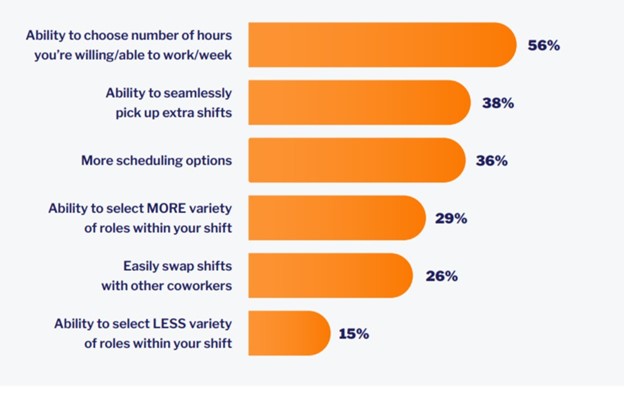Motivation is the vital difference between a highly dedicated and efficient workforce and one indifferent to the business’s operational needs. However, organizations often overlook hourly workers when applying techniques to increase employee satisfaction. This article will share how businesses can improve hourly employee engagement and keep all workers motivated throughout their employment.
The Importance of Motivation for Hourly Workers
When considering benefits, incentives, and worker support, there is a tendency for organizations to focus mainly on salaried employees. But because hourly workers make up more than half (58%) of the current workforce, motivating them is also essential.
After the Great Resignation, and with quiet quitting still ongoing, it’s becoming harder for organizations to nurture and retain talent. Motivating hourly employees is essential for improving their productivity and satisfaction. Additionally, an engaged workforce creates a more positive work environment—and benefits from it. Improving employee motivation can help your organization by increasing gross revenue by up to 47%. Investing in effective employee motivation strategies is crucial for companies seeking to enhance their bottom line and maintain a strong workforce.
How Important Is the Hourly Workforce in the U.S.?
Hourly workers are the backbone of the American workforce, representing a huge portion of workers. In 2021, there were 76.1 million hourly workers aged 16 and older in the United States. The industries with the most hourly employees are retail, education, health services, and hospitality.
Hourly workers’ satisfaction is typically below that of salaried employees, even within the same company. On average, hourly workers have changing schedules and lower wages, which impacts their job engagement. According to the 2022 survey by Great Place to Work in the U.S., fewer than half of hourly employees find their work meaningful. Here are some additional highlights:
- 48% of hourly workers feel they receive fair compensation for their work.
- 47% believe that promotions are awarded impartially.
- Hourly workers are a large percentage of the Great Resignation trend.
7 Ways to Improve Hourly Employee Engagement
There are several retention strategies businesses can utilize to provide more attractive workplaces for their temporary staff and improve hourly employee engagement. Here are our top tips:
1. Offer Flexible Schedules
Work-life balance is one of the most sought-after factors for current employees, especially those working for an hourly wage. One study found that over half of the employees surveyed wanted a more flexible schedule and control over when and how much to work.

2. Deliver Competitive Compensation
Hourly employees typically don’t have the same benefits as salaried employees. That’s why it’s vital to ensure they are fairly compensated, as well as to take care to reflect the cost of living in your area. Just a $1 per hour increase in pay can significantly raise the likelihood of employee retention.
3. Offer Perks
Everybody likes perks; even the most minor benefits can make a difference. There is a good reason leading companies offer free coffee, healthy snacks, and discounts to local events or stores—these all help meet workers’ needs and show that they are appreciated.
4. Improve Your Workplace Culture
Take a good look at your workplace culture. Is your company known for its positivity and collaboration? Is there trust between employees and management? Are there enough internal promotions? All of these factors contribute to a company’s culture and the employees’ experiences. Assess your organization’s culture and make necessary changes so you can retain your top talent.
5. Help Workers Develop Their Careers
One of the best strategies to retain workers is to provide them with training and opportunities for development. Sadly, many companies only offer these programs for salaried employees. After the pandemic, top companies like Hilton and Target implemented educational programs for hourly employees with the growth in hourly positions. Hilton covers continuing education through its Guild Education program. Target’s program covers workers’ tuition for undergraduate and associate degrees.
6. Offer Recognition
Hourly employees often feel secondary to salaried team members, but managers know they’re integral to the company’s success. Proper and deserved recognition can go a long way in making your whole team feel engaged. Leaders should identify and recognize employees’ accomplishments and report them to management. Employees who feel acknowledged are usually more productive and are more satisfied with their jobs.
7. Involve Hourly Employees in Planning
Another way of making hourly employees feel like part of the company is by involving them in decision-making. Engaging them in sharing ideas, attending brainstorming sessions, and requesting feedback shows they’re a valued part of the team. Hourly employees should receive communications along with other employees and be part of company announcements, functions, and team-building events.
You can find more tips and tricks here.
How Software Can Unlock Operational Insight Necessary for Identifying Employee Trends
Software tools can help organizations unlock the operational insight necessary for identifying employee trends. Recent market changes and disruptions require organizations to have a workforce with digital skills and to use innovative processes to respond to both customers’ and employees’ evolving needs. Thus, companies must have access to intelligent workflows for talent management that can allow them to analyze employee trends and gain insights from the data collected.
The first step to keeping your employees engaged is to understand them.
Similarly, HR leaders must evaluate and embrace strategies to improve the employee experience by incorporating technology into HR practices. This can help organizations use data and advanced analytics to understand employee tendencies, desires, and behaviors better.
HR-driven data, such as people analytics (which involves collecting and analyzing employee data at scale), can provide insights into employee trends. These tools and techniques help organizations to create standard processes and improve workflows and culture to meet the organization’s goals, as well as to monitor employee behavior and identify trends that can lead to improved performance and increased hourly employee engagement.
Explore How Nowsta Can Improve Hourly Employee Engagement
Hourly employees require the same motivation as salaried staff to remain loyal and have satisfaction from their work. The right software can detect employee trends and needs so you can keep staff engaged and motivated. With Nowsta, you can create an environment with streamlined operations that fosters staff communication, builds teams, and supports a glowing company culture—creating an environment where people will want to work.
To learn more about how Nowsta can improve your hourly employee engagement, contact a Nowsta expert today.
